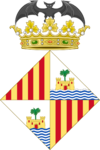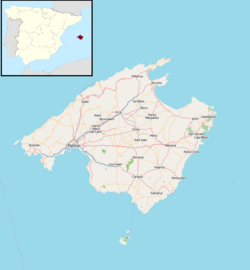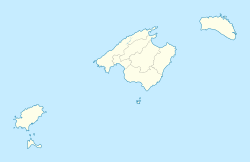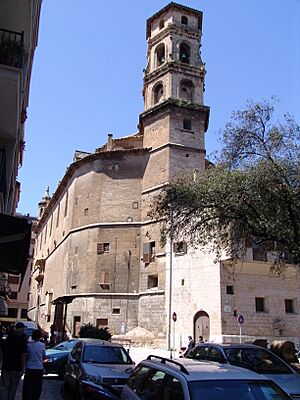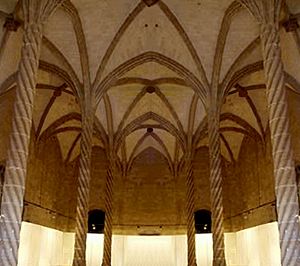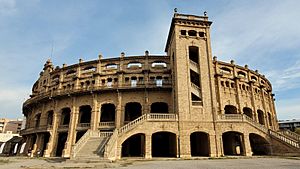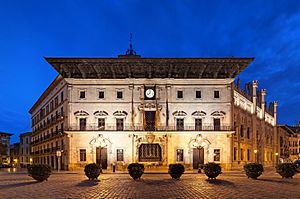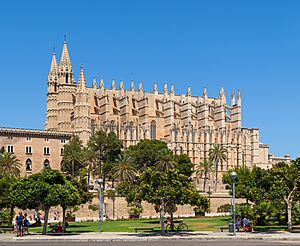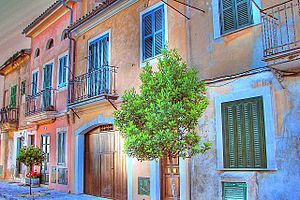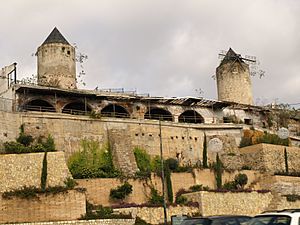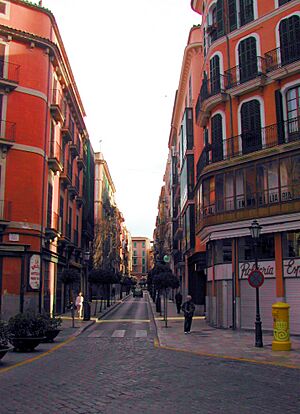Palma de Mallorca facts for kids
Quick facts for kids
Palma
|
|||
|---|---|---|---|
|
|
|||
|
|||
| Nickname(s):
Ciutat de Mallorca (commonly shortened to Ciutat)
|
|||
| Country | Spain | ||
| Autonomous community | Balearic Islands | ||
| Province | Balearic Islands | ||
| Island | Majorca | ||
| Comarca | Palma | ||
| Judicial district | Palma | ||
| Founded | 124 BC | ||
| Administrative HQ | Palma City Hall | ||
| Government | |||
| • Type | Municipal corporation | ||
| • Body | Ajuntament de Palma | ||
| Area | |||
| • Capital city and municipality | 208.63 km2 (80.55 sq mi) | ||
| Elevation | 13 m (43 ft) | ||
| Population
(2018)
|
|||
| • Capital city and municipality | 409,661 | ||
| • Density | 1,963.58/km2 (5,085.64/sq mi) | ||
| • Urban | 550,000 | ||
| Demonym(s) | palmesà, -ana (ca) palmesano, -na (es) |
||
| GDP | |||
| • Metro | €21.456 billion (2020) | ||
| Time zone | UTC+1 (Central European Time) | ||
| • Summer (DST) | UTC+2 (Central European Summer Time) | ||
| Postal code |
070XX
|
||
| Dialing code | 971 | ||
| Website | www.palma.es | ||
Palma (also called Palma de Mallorca) is the capital city of the Balearic Islands in Spain. It's located on the south coast of Mallorca island, right on the Bay of Palma. Even though it's far away, the Cabrera Archipelago is also part of Palma's local government area.
Contents
History of Palma
Palma started as a Roman army camp. It was built on top of an older settlement from the Talaiotic period. Over time, the city was attacked by the Vandals, then taken over by the Byzantine Empire. Later, Moors ruled it, calling it Medina Mayurqa. In the 13th century, James I of Aragon took control.
Roman Times
After the Romans conquered Mallorca, they founded two new cities. Palma was in the south, and Pollentia was in the northeast. Pollentia was a port for Roman cities in the northwest. Palma was used for trips to Africa, like Carthage, and other parts of Hispania. Today, you can still see parts of the old Roman wall in Palma.
Byzantine Times
Not much is known about Palma between the fall of the Western Roman Empire and the Muslim conquest. But there is proof that the Byzantines were here. Mosaics found in the oldest parts of the cathedral show that it was once a very old Christian temple.
Muslim Times
From 902 to 1229, the city was under Islamic rule. It remained the island's capital and was known as Medina Mayurqa. This Arabic name means "City of Majorca."
Under the Emirate of Córdoba
The Moors arrived in the Balearic Islands in the early 8th century. At first, the people lived by themselves and sometimes engaged in piracy. In 707, a Muslim fleet arrived and made a peace treaty with the city leaders. This meant the city paid a tax but kept its way of life and religious beliefs.
For a long time, the city was home to Christians who were loyal to the Umayyad Caliphate but mostly ran their own affairs. Because it was between Christian and Islamic lands, piracy became common. This led to attacks from Al-Andalus. In 848, the city had to agree to the treaty again.
Later, the Emirate of Córdoba decided to fully take over the islands. In 902, a group led by Isam al-Jawlani landed in Mallorca. They took control, making Palma the capital of the island under Córdoba. This led to a big growth in trade and manufacturing. Medina Mayurqa became an important trading port.
Dénia—Balearic Taifa (1015–1087)
In the 11th century, the main government in Córdoba became weaker. Different areas broke away and formed their own states called taifas. Palma became part of the taifa of Dénia. This state was founded by Muyahid ibn Yusuf ibn Ali in 1015.
Palma became a key port for launching attacks on Christian ships. For example, a campaign against Sardinia was launched from Palma in 1016-1017. This led to forces from Pisa and Genoa getting involved. This also helped Italian traders start doing business in the city.
The rule of Dénia lasted until 1087. During this time, Palma and the islands were mostly peaceful. They were strong at sea, so there were few threats from outside.
Balearic Taifa (1087–1115)
When Dénia was taken over by the taifa of Zaragoza, the islands became independent for a short time. Medina Mayurqa was the capital. The city's economy relied on farming and piracy. But Christian countries started to become stronger at sea. This meant less money from piracy, which caused problems for the city.
In 1115, Palma was attacked and later left empty by an expedition. This group included soldiers from Barcelona, Pisa, and other places. They wanted to stop the Almoravids from controlling the area. After this, the islands became part of the Almoravid empire.
Banu Ganiya Period (1157–1203)
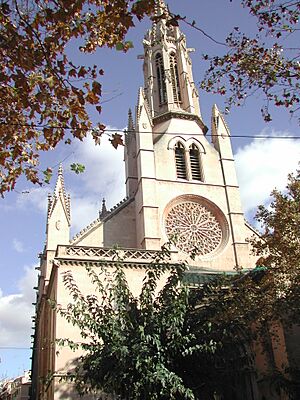
Things changed in the mid-12th century. The Almoravids lost control of their lands to the Almohads. From 1157, the Almoravids only held the Balearic Islands, with Palma as their capital. The ruler was Muhammad ibn Ganiya. Many people who had to leave Al-Andalus came to Palma. This made the Almoravids stronger. They also started to work with powerful Italian trading cities like Genoa and Pisa. These cities got their first trading rights in Palma.
In 1184, the Banu Ganiya attacked Ifriqiya. But this attack failed, and the Almohad rulers encouraged people in the islands to revolt against the Almoravids. The Almohads captured Palma in 1203.
Christian Reconquest and Later Middle Ages

On December 31, 1229, after three months of fighting, James I of Aragon took the city back. He renamed it Ciutat de Mallorca (Mallorca City). It remained the capital of the Kingdom of Majorca. The city was given control over the whole island.
After James I died, Palma became a joint capital with Perpignan. His son, James II of Majorca, built many important buildings in the city. These include Bellver Castle, the churches of St. Francesc and St. Domingo, and he started building the Cathedral of Majorca. He also improved the Palace of Almudaina.
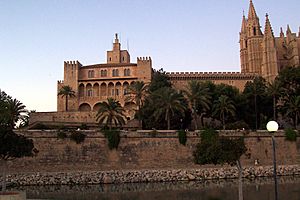
In 1391, there were problems for the Jewish community. Many Jewish people had to leave the island or change their religion. Abraham Cresques was a famous Jewish mapmaker from Palma in the 14th century. He created the well-known Catalan Atlas.
The river that ran through the city divided it into two parts: the "Upper town" and "Lower town." Palma's good location helped it trade a lot with places like Catalonia, Valencia, and Italy. This was a very successful time for the city.
In the early 16th century, a peasant uprising and frequent attacks by Turkish and Berber pirates caused trade to slow down. A lot of money was spent on building defenses. Because of this, the city went through a difficult period until the late 17th century.
17th to 19th Centuries

The 17th century saw the city divided into two rival groups, the Canamunts and Canavalls. This caused many social and economic problems. The port also became a place where pirates would hide. Towards the end of the century, the Inquisition continued to target the city's Jewish descendants, known as xuetes. These families often married only within their own group.
In 1714, the War of the Spanish Succession ended. This led to changes in how the island was governed. Palma became the official name of the city. By the end of the 19th century, the name Palma de Mallorca was commonly used. In the 18th century, Charles III of Spain allowed trade with Spanish colonies in America again. This helped the city's port and trade grow.
In the early 19th century, many people who had to leave their homes because of the Napoleonic occupation of Catalonia came to Palma. The French taking over Algeria in the 19th century meant there was less fear of attacks from North Africa. This opened up new sea routes and helped the city's economy grow.
Modern Times
Since the 1950s, when many tourists started visiting, Palma has changed a lot. It has become a popular tourist spot. Many workers from mainland Spain have moved here. This has changed the city's traditions, language, and economy.
Tourism has made Palma grow very quickly. In 1960, Mallorca had 500,000 visitors. By 1997, it had more than 6.7 million. In 2001, over 19 million people passed through Son Sant Joan airport near Palma. Another 1.5 million arrived by sea.
In the 21st century, city improvements have brought many workers from outside the European Union, especially from Africa and South America. More than half of Palma's population, about 80%, works in tourism. This makes tourism the main part of Palma's economy. Tourism has helped Mallorca become one of the wealthiest areas in Spain.
Another important part of Palma's economy is agriculture. The main things grown and sent out from Palma are almonds, oranges, lemons, and olives. The island also has natural resources like copper, lead, and marble mines.
Palma also has several nearby communities, including Establiments, Nord, Son Espanyol, Ces Cases Noves, and Sa Creu Vermella. In October 2021, Palma was chosen as a finalist for the 2022 European Capital of Smart Tourism award.
Geography of Palma
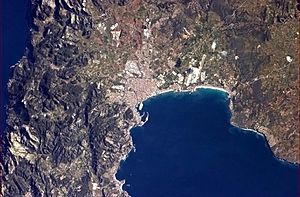
Palma is a big city and seaport in the southwest of Mallorca. Mallorca is an island in the western Mediterranean Sea, part of the Balearic Islands. The city covers about 21.355 square kilometers (8.245 sq mi). It is about 13 meters (43 ft) above sea level.
The center of Palma is north of the Bay of Palma. To the east, there is a flat, fertile plain called Es Pla. To the north and west, the city is next to the Serra de Tramuntana. This is the island's main mountain range and a Unesco World Heritage site.
Climate
Palma has a Hot-summer Mediterranean climate. This means it has mild winters and hot but not extremely hot summers. The average yearly temperature is 18.2 °C (64.8 °F). In January, the coldest month, the average high is 15.4 °C (59.7 °F) and the low is 8.3 °C (46.9 °F). In August, the warmest month, the average high is 29.8 °C (85.6 °F) and the low is 22.5 °C (72.5 °F).
Autumn is the wettest season, with heavy rain and storms sometimes. Palma gets about 2800 hours of sunshine each year. The sea helps keep temperatures mild. Freezing temperatures are very rare. The sea temperature in Mallorca averages 19.5 °C (67.1 °F). Beach weather usually lasts for 6–7 months, from late April to early November.
| Climate data for Palma de Mallorca, Port (1981-2010), extremes (1978-2021) (Satellite view) | |||||||||||||
|---|---|---|---|---|---|---|---|---|---|---|---|---|---|
| Month | Jan | Feb | Mar | Apr | May | Jun | Jul | Aug | Sep | Oct | Nov | Dec | Year |
| Record high °C (°F) | 24.2 (75.6) |
24.4 (75.9) |
26.6 (79.9) |
28.0 (82.4) |
32.0 (89.6) |
36.5 (97.7) |
38.0 (100.4) |
37.8 (100.0) |
35.5 (95.9) |
31.2 (88.2) |
27.6 (81.7) |
23.4 (74.1) |
38.0 (100.4) |
| Mean daily maximum °C (°F) | 15.4 (59.7) |
15.5 (59.9) |
17.2 (63.0) |
19.2 (66.6) |
22.5 (72.5) |
26.5 (79.7) |
29.4 (84.9) |
29.8 (85.6) |
27.1 (80.8) |
23.7 (74.7) |
19.3 (66.7) |
16.5 (61.7) |
21.8 (71.2) |
| Daily mean °C (°F) | 11.9 (53.4) |
11.9 (53.4) |
13.4 (56.1) |
15.5 (59.9) |
18.8 (65.8) |
22.7 (72.9) |
25.7 (78.3) |
26.2 (79.2) |
23.5 (74.3) |
20.2 (68.4) |
15.8 (60.4) |
13.1 (55.6) |
18.2 (64.8) |
| Mean daily minimum °C (°F) | 8.3 (46.9) |
8.4 (47.1) |
9.6 (49.3) |
11.7 (53.1) |
15.1 (59.2) |
18.9 (66.0) |
21.9 (71.4) |
22.5 (72.5) |
19.9 (67.8) |
16.6 (61.9) |
12.3 (54.1) |
9.7 (49.5) |
14.6 (58.3) |
| Record low °C (°F) | 0.0 (32.0) |
−0.1 (31.8) |
1.6 (34.9) |
4.4 (39.9) |
8.0 (46.4) |
11.0 (51.8) |
16.4 (61.5) |
15.8 (60.4) |
10.0 (50.0) |
8.4 (47.1) |
3.8 (38.8) |
2.5 (36.5) |
−0.1 (31.8) |
| Average precipitation mm (inches) | 43 (1.7) |
37 (1.5) |
28 (1.1) |
39 (1.5) |
36 (1.4) |
11 (0.4) |
6 (0.2) |
22 (0.9) |
52 (2.0) |
69 (2.7) |
59 (2.3) |
48 (1.9) |
449 (17.7) |
| Average precipitation days (≥ 1 mm) | 6 | 6 | 5 | 5 | 4 | 2 | 1 | 2 | 5 | 7 | 6 | 7 | 53 |
| Average snowy days | 0.3 | 0.1 | 0 | 0 | 0 | 0 | 0 | 0 | 0 | 0 | 0 | 0 | 0.4 |
| Average relative humidity (%) | 73 | 72 | 70 | 68 | 69 | 69 | 68 | 70 | 72 | 74 | 74 | 74 | 71 |
| Mean monthly sunshine hours | 167 | 170 | 205 | 237 | 284 | 315 | 346 | 316 | 227 | 205 | 161 | 151 | 2,779 |
| Percent possible sunshine | 54 | 55 | 55 | 61 | 66 | 70 | 75 | 73 | 63 | 60 | 54 | 54 | 62 |
| Source: Agencia Estatal de Meteorología | |||||||||||||
| Climate data for Palma | |||||||||||||
|---|---|---|---|---|---|---|---|---|---|---|---|---|---|
| Month | Jan | Feb | Mar | Apr | May | Jun | Jul | Aug | Sep | Oct | Nov | Dec | Year |
| Average sea temperature °C (°F) | 14.4 (57.9) |
13.9 (57.0) |
14.1 (57.4) |
15.9 (60.7) |
18.9 (66.1) |
22.5 (72.5) |
24.9 (76.7) |
26.0 (78.8) |
25.0 (77.1) |
22.7 (72.9) |
19.7 (67.4) |
16.3 (61.4) |
19.5 (67.2) |
| Mean daily daylight hours | 10.0 | 11.0 | 12.0 | 13.0 | 14.0 | 15.0 | 15.0 | 14.0 | 12.0 | 11.0 | 10.0 | 9.0 | 12.2 |
| Average Ultraviolet index | 2 | 3 | 5 | 6 | 8 | 9 | 9 | 8 | 6 | 4 | 2 | 2 | 5.3 |
| Source: seatemperature.org | |||||||||||||
| Source: Weather Atlas | |||||||||||||
Population of Palma
| Historical population | ||
|---|---|---|
| Year | Pop. | ±% |
| 1842 | 40,892 | — |
| 1857 | 51,871 | +26.8% |
| 1860 | 53,019 | +2.2% |
| 1877 | 59,159 | +11.6% |
| 1887 | 61,052 | +3.2% |
| 1897 | 62,626 | +2.6% |
| 1900 | 63,873 | +2.0% |
| 1910 | 68,416 | +7.1% |
| 1920 | 78,363 | +14.5% |
| 1930 | 87,746 | +12.0% |
| 1940 | 117,188 | +33.6% |
| 1950 | 133,397 | +13.8% |
| 1960 | 157,131 | +17.8% |
| 1970 | 217,525 | +38.4% |
| 1981 | 290,372 | +33.5% |
| 1991 | 296,754 | +2.2% |
| 2001 | 333,801 | +12.5% |
| 2011 | 402,044 | +20.4% |
| 2021 | 424,837 | +5.7% |
| Source: National Statistics Institute | ||
As of 2022, Palma had a population of 415,940 people. The larger urban area had about 550,000 people. This makes it the twelfth largest urban area in Spain. By early 2019, the city's population grew to 416,065. Almost half of all people living on Mallorca live in Palma.
In 2017, over 60,000 non-Spanish people from other countries lived in Palma. However, the number of registered foreign residents went down slightly from 2016 to 2017.
Main Sights in Palma
Plaça d'Espanya
The Plaça d'Espanya is a main transport hub in Palma. Here you'll find the Palma Intermodal Station, which has buses and trains. The old buildings nearby have a tourist information center. There are also cafes and a large park above the station. The park has train-themed play areas. The Ferrocarril de Sóller, a railway from 1911, has its Palma station right next to the park. In the center of the plaza is a statue of James I of Aragon, who conquered Majorca.
Cathedral Area
Palma is famous for La Seu, its huge cathedral. It was built on the site of an old mosque, which was built on an even older Christian church. Construction of the cathedral started in 1229 but wasn't finished until 1601. In 1901, the famous architect Antoni Gaudí helped restore the building. The Parc de la Mar (Park of the Sea) is just south of the cathedral. The cathedral sits on the city's old stone foundations, overlooking the park. The old city walls are between them.
The Rocks
The rocks near the cathedral are a peaceful and quiet place to visit.
Old City
The Old City is in the southeast part of Palma, behind the cathedral. It's like a maze of narrow streets that show its Arab past. Most of these streets are quiet and have interesting buildings. Many are private homes, but some are open to the public as museums or galleries. The Old City is also home to the Ajuntament (Town Hall), the Convent of the cathedral, and the Banys Àrabs.
Banys Àrabs (Arab Baths)
The Banys Àrabs, or Arab Baths, are one of the few remaining parts of Palma's Moorish history. You can find them on Ca'n Serra street, near the Convent of the cathedral. They include the beautiful gardens of Ca'n Fontirroig, with many plants and birds. The small brick building that held the baths is from the 11th century. It might have been part of a Muslim nobleman's home. The main bath room has a dome with five openings that let in light. The twelve columns supporting the room were taken from an older Roman building.
Notable People from Palma
Many famous people were born in Palma, including:
- Rafael Nadal (born 1986), a tennis player and 22-time Grand Slam champion.
- Álex Abrines (born 1993), a basketball player for the Oklahoma City Thunder.
- Marco Asensio (born 1996), a footballer for Paris Saint-Germain.
- Rudy Fernández (born 1985), a basketball player for Real Madrid.
- Lorenzo Fluxá (born 2004), a racing driver.
- Ramon Llull (around 1232–1315/16), a philosopher and writer.
- Jorge Lorenzo (born 1987), a motorcyclist and five-time MotoGP champion.
- Joan Mir (born 1997), a motorcyclist and Moto 3 and MotoGP champion.
- Guillermo Pont (born 1921), a footballer.
- Luis Salom (1991–2016), a motorcyclist.
- Agustí Villaronga (1953–2023), a filmmaker.
- Rossy de Palma (born 1964), an actress.
- Margalida Caimari Vila (1839–1921), a poet.
- Izan Guevara (born 2004), a motorcyclist.
Sports in Palma
Football is the most popular sport in Mallorca. The main team is La Liga club Real Mallorca, which plays at the Estadi de Son Moix. There's also Segunda División B club CD Atlético Baleares.
Basketball is also popular. Palma's top team is CB Bahía San Agustín. They play their home games at the Palau Municipal d'Esports Son Moix.
Because Palma is on the coast, all sea sports are very important. One of the biggest sports events in the city is the Ciutat de Palma Prizes.
Road cycling is popular in Mallorca. An international race for professional cyclists, the Vuelta a Mallorca, happens in February. The first day of this race is a circuit around the streets of Palma. The city also has the Palma Arena, a large venue with a velodrome for cycling.
In June 2016, Palma took part in the First World Company Sports Games. This event brought together culture, sport, and community in Mallorca. It was a big success for both locals and tourists. In 2023, Palma hosted the finals of the 2022–23 UEFA Futsal Champions League.
Transport in Palma
- Palma de Mallorca Metro: The city has its own subway system.
- Mallorca rail network: There are also train lines connecting Palma to other parts of Mallorca.
- Palma de Mallorca Airport: This is the main airport for the island.
- The city bus system is run by the EMT. It includes a route that goes through the historic center.
- Another bus system, run by the TIB, connects Palma to nearby towns like Calvià.
- Palma has a fleet of 1246 taxis. They all have air conditioning and most have a radio. Taxis used to be black and ivory, but now they are white.
Twin Towns – Sister Cities
Palma de Mallorca is connected with these cities:
Images for kids
See also
 In Spanish: Palma de Mallorca para niños
In Spanish: Palma de Mallorca para niños








